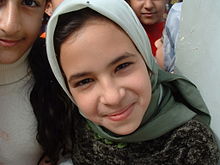Hijab
The word hijab is used in the Qur'an to denote a partition, or a curtain,[1][2] but in modern usage often refers to a woman's headscarf. This is often done amongst Muslims for females over the age of puberty.[3][4] For most Muslims, the headscarf, a symbol of hijab, is worn in the presence of adult males outside their immediate family; it is not necessary when females or males are within their immediate family. However, some Muslim scholars and activists maintain that the practice of covering the hair with a hijab is not mandated in Islam.[5][6][7][8]

The word ḥijāb, or a derivative, appears eight times in the Qur'an and never connotes any act of piety or headscarf.[9] It appears as an "obstacle" (7:46), a "curtain" (33:53), "hidden" (38:32), a "wall of separation" (41:5, 42:52, 17:45), "hiding" (19:14) and "prevented" or "denied access to God" (83:15).[10]
The "hijab" as a headscarf can come in several different types, such as an ordinary veil (which only covers the head), a niqab, a burka also known as an abayah, which covers the entire body, and any form of covering used to veil.[11] There are many styles to wear. The Quran however has no requirement that women cover their faces with a veil, or cover their bodies with the full-body burqa or chador.[12]
The "hijab" as a headscarf is currently required by law to be worn by women in Iran and Afghanistan.[13] It is no longer required by law in Saudi Arabia since 2018.[14][15][16][17][18][19] In Gaza, Palestinian jihadists belonging to the Unified Leadership (UNLU) have rejected a hijab policy for women.[20] They have also targeted those who seek to impose the hijab.[20] Other countries, both in Europe and in the Muslim world, have passed laws banning some or all types of hijab in public or in certain types of locales.
Related pages
changeReferences
change- ↑ Mark Juergensmeyer, Wade Clark Roof, ed. (2012). "Hijab". Encyclopedia of Global Religion. Vol. 1. SAGE Publications. p. 516. doi:10.4135/9781412997898. ISBN 9780761927297.
- ↑ El Guindi, Fadwa; Sherifa Zahur (2009). Hijab. The Oxford Encyclopedia of the Islamic World. doi:10.1093/acref/9780195305135.001.0001. ISBN 9780195305135.
- ↑ Murphy R.F. 1964. Social distance and the veil. American Anthropologist. New Series, 66, No. 6, Part 1, pp. 1257–1274.
- ↑ Brenner S. 1996. Reconstructing self and society: Javanese Muslim women and "the veil". American Ethnologist, 23, (4) , pp. 673–697.
- ↑ "unicornsorg". Archived from the original on 21 December 2015. Retrieved 26 December 2015.
- ↑ "Moroccoworldnews.com". Archived from the original on 27 December 2015. Retrieved 26 December 2015.
- ↑ Nomani, Asra Q.; Arafa, Hala (21 December 2015). "Opinion: As Muslim women, we actually ask you not to wear the hijab in the name of interfaith solidarity". Washington Post. Retrieved 22 December 2022.
- ↑ "No Ritu Kumar, all Muslim women don't wear hijab - the New Indian Express".
- ↑ https://www.washingtonpost.com/news/acts-of-faith/wp/2015/12/21/as-muslim-women-we-actually-ask-you-not-to-wear-the-hijab-in-the-name-of-interfaith-solidarity/
- ↑ https://www.washingtonpost.com/news/acts-of-faith/wp/2015/12/21/as-muslim-women-we-actually-ask-you-not-to-wear-the-hijab-in-the-name-of-interfaith-solidarity/
- ↑ Wear, Muslima. "Muslima Hijabs". Muslima Wear. Retrieved 2021-12-02.
- ↑ Tristam, Pierre. Does the Quran require women to wear the veil? About News. [1] Archived 2014-10-11 at the Wayback Machine
- ↑ "'Why didn't you wear a hijab?' Taliban militants shoot 21-year-old Afghan girl". News Track. 5 August 2021. Retrieved 15 August 2021.
- ↑ Schams Elwazer (28 May 2014). "Skimpy clothing targeted in Gulf cover-up campaigns". CNN. Retrieved 2022-08-02.
- ↑ "9 Misconceptions about traveling to Saudi Arabia as a woman - Against the Compass". 2021-01-09. Retrieved 6 February 2021.
I did not cover my hair because, one, it's not the law, and two, I didn't have a scarf anyway.
- ↑ Abdulaziz, Donna (2 October 2019). "Saudi Women Are Breaking Free From the Black Abaya". The Wall Street Journal. ISSN 0099-9660. Retrieved 6 February 2021.
Almost immediately, women became more comfortable wearing their headscarves loosely or not at all
- ↑ "Women in Saudi Arabia do not need to wear head cover, says crown prince". The Irish Times. Retrieved 6 February 2021.
This, however, does not particularly specify a black abaya or a black head cover. The decision is entirely left for women to decide what type of decent and respectful attire she chooses to wear.
- ↑ Nic Robertson (December 5, 2020). "Saudi Arabia has changed beyond recognition. But will tourists want to visit?". CNN.
- ↑ Mail, Daily (15 September 2019). "Rebel Saudi women appear in public without hijab, abaya; onlookers stunned | New Straits Times". NST Online. Retrieved 13 January 2021.
- ↑ 20.0 20.1 "Women, the Hijab and the Intifada". 4 May 1990.